For the first time in more than four months, rain drops dribble down the windows of my van. At the end of November, I drove through a day of rain in the Appalachians as I headed south from New Hampshire en route to Mexico for the winter. But I haven’t seen wet weather since I crossed into Texas, New Mexico, Arizona, Southern California, and on to Baja in January. In Joshua Tree and Quartzsite I marveled at a few stray drops that landed on my windshield, but nothing dripped, drizzled, sogged, or turned the dry desert dust to mud, until today.
It’s the first time in 143 days on the road that I’m cozied up in my 1999 Roadtrek camper van with the heater running, the dogs napping, and my built-in desk deployed as wind and rain chill the 42-degree air outside. Last weekend I hiked three miles down the Grand Canyon on a sunny, 80-degree day; tonight, the temperature will dip below freezing. Such is Arizona in springtime.
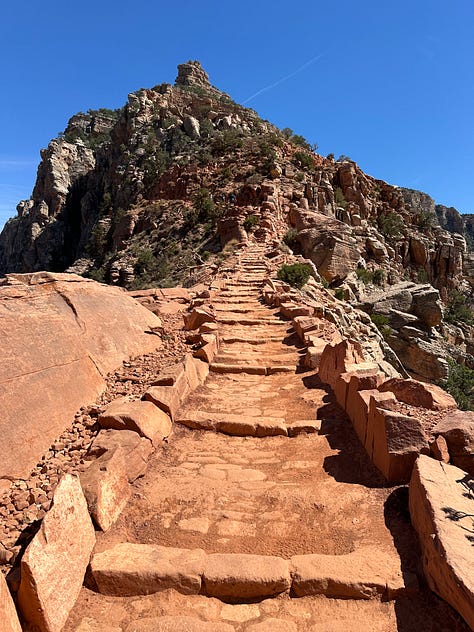
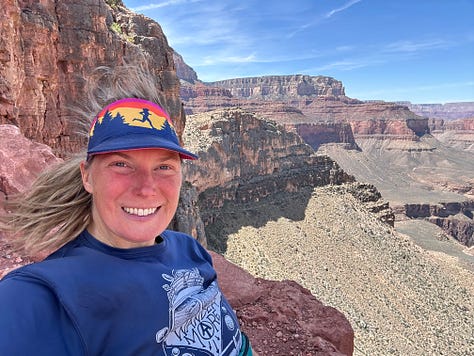


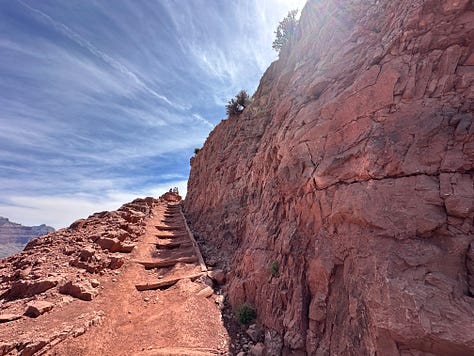
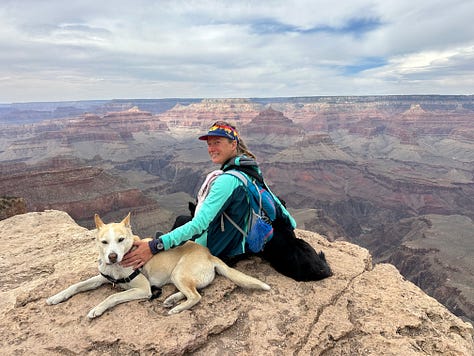
I crossed the border from Baja two and a half weeks ago, and it’s taken me this long to get my bearings. I traveled exactly ten weeks in Mexico, alone with my dogs, for the first time. I learned a lot. I had some out-of-this-world magical moments. But every day was also really, really hard.
I wrote early in my trip about the challenges of traveling in Baja. Crossing the border and making it through the murdery part of the peninsula was one of the more stressful aspects (which played out in reverse on my way back). I’d had no time to plan, beyond getting myself there, so I spent most of my days in the first few weeks figuring out where I was, where I was going, and where to get what I needed (talking to locals and fellow travelers helped immensely with this, and writing down everything they suggested). Then once I had a plan, I spent the next few weeks scheming Seth’s trip to come see me, and getting myself five-hundred miles south to Cabo by the time his flight arrived.
My itinerary was complicated by multiple extended stays at the mechanic. Luckily I found a good one in Mulege, thanks to a retired expat couple from California who picked me up off the side of the highway when my van broke down and let me camp in the backyard of their riverfront casita while I awaited shipment of a new radiator. Their mechanic Daniel Bukovecz spoke perfect English and went out of his way to get me back on the road. Unfortunately, two weeks later I found myself back in his shop following an accidental six-hour trip down a four-wheel-drive road in the mountains that wrecked my suspension (by the time I realized what I’d gotten myself into, there was no turning back). I spent another week in the shop while Daniel replaced two ball joints and control arms and patched up some other parts that had broken loose.
By the time I made it to Cabo to pick up Seth, I’d spent almost as many days at the mechanic as I had at the beach. Our two weeks together got off to a rocky start, but the argument that nearly ended our marriage brought us closer, and the rest of our time together felt really special. We drove from Los Cabos to the East Cape and La Paz, camping on white-sand beaches overlooking clear turquoise waters, watching whales breach and slap their tails, snorkeling with hundreds of colorful reef fish, and paddling with the dogs to a secluded spot we dubbed “Honeymoon Beach” (since we got married during Covid, we’ve counted every trip as our honeymoon).


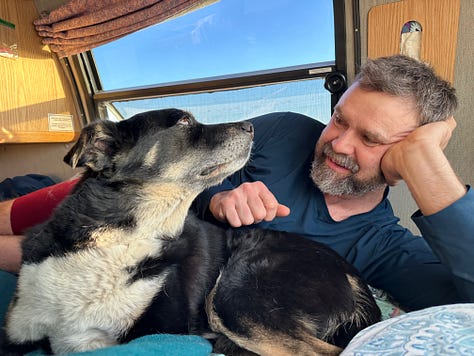
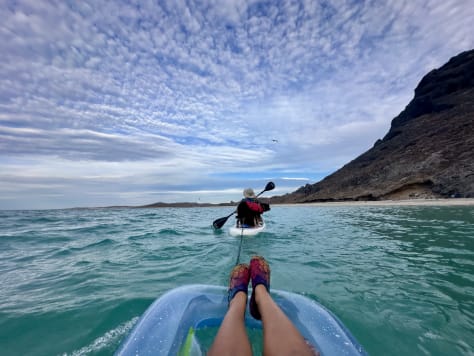
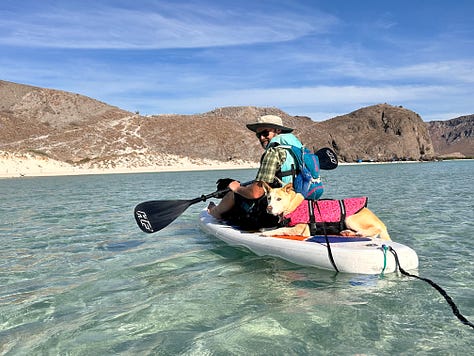
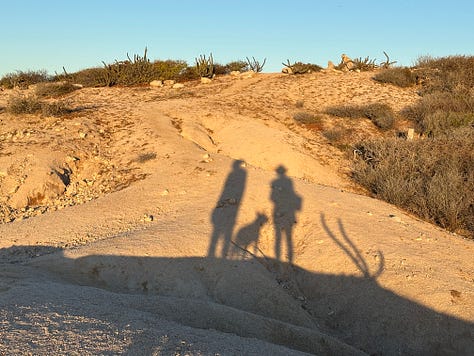



Once Seth and I quit bickering and settled into our life in the van together, I felt my body begin to relax for the first time since I’d left home. Van life is a grind even on the best of days, with the drudgery of daily tasks amplified by the small space, nonexistent storage, and limited supply of water, power, and septic capacity. It takes an hour to Tetris a cart-full of groceries into a two-cubic-foot refrigerator. It takes an hour from start to finish to set up the shower, bathe with Navy-style squirts of water, dry the curtain and the floor, and put it away. It takes an hour every few days to dump the black and gray tanks and fill the water tank. It takes two hours to dig the cookpot out from the back of the cabinet, chop the two-cubic-feet-worth of vegetables occupying the fridge, cook up a stir fry, and wash everything in the tiny sink without using too much water. Sharing these tasks takes a huge load off—or, in my case, letting Seth take on most of them so I could finally have a break.
Seth’s presence also drastically reduced the stress of the usual van crises, since he’s skilled and equipped to handle most mechanical things. On our third day together I was tapping the shower head to get all the drips out before I put it back in the closet, and the plastic bracket holding the sprayer to the wall snapped in half. On my own, this would have meant weeks of washing my hair one-handed while holding the shower wand over my head, then paying a mobile mechanic hundreds of dollars to fix it back in the US. Seth went to the hardware store the next day, bought a screw, and engineered a solution.
At Playa El Tecolote, we spent an afternoon lounging in bed with the back door open to the shimmering water, looking out at the craggy silhouette of Isla Espiritu Santo and pondering our future. I told him how good it felt to be traveling together. I pointed out that exploring new places brought back the spark from early in our relationship. He’d wooed me on our first date using a headlamp to illuminate the eye shine of frogs on an after-dinner walk in a wetland, and sealed the deal a week later when he spent two hours crouched next to a tree trunk with me watching a cicada nymph metamorphose into an adult. The tedium of daily life back home meant we hadn’t shared many moments like that in recent years; Seth worked all day and spent evenings and weekends fixing our fleet of ancient vehicles and doing projects around the house. In Baja van life, we awoke every morning to a beach sunrise, watched whales smack their tails offshore and sharks surf the waves, and worked as a team to keep the dogs happy and get the daily chores done. There was less to worry about, and more to enjoy.
Was it ridiculous to think about turning our lives into a perpetual vacation? Was it even possible? What would it take?
In my travels, I’ve met many couples who’ve made it work. They sell their house and most of their stuff, simplify their expenses, and either save a bunch of money, work seasonally, or parlay their experience into passive income on YouTube or social media. I know it can work because I’ve seen it work.
Seth and I took a look at our finances: selling our house would earn us a cash profit and eliminate at least $20,000 in expenses a year. What else could we trim from our budget? Healthcare and veterinary care are generally cheaper in Mexico and Canada than the US, and we could spend up to six months a year in each country (*pending any future political crises). Boondocking and traveling at a slower pace saves on campground and fuel prices. Food is cooked in the van. Could we save just enough and work just enough to make it happen?
The thought quickened my pulse and sent a rush of energy from my belly to my throat. It was the first time in my four-month trip that I’d truly felt excited. I’d been so stuck in the daily grind and stressed about planning my next move that I hadn’t truly felt happy, despite some incredible experiences along the way. The thought of traveling as a team, with Seth by my side, suddenly felt right. We’d been struggling to envision what life would look like in another year (or another decade) if I stayed on the road, away from home and away from him. If he could join me—problem solved!
But could I really sell my house? It’s the one asset I own. I cashed out a very meager retirement two years ago to buy my Roadtrek. Due to my mental health, I am chronically unemployed/underemployed/self-employed and doubt I’d ever be able to get a mortgage again on my own. My house has been the one constant in my life through over a decade of turmoil, and I vowed to never give it up. It represents my last thread of independence.
Except… I kind of hate it. The house itself is cute, the location is nice, but the memories haunt me. I probably should have left my small town ten years ago after my first marriage collapsed. Instead, I vowed to rebuild the same life in the same place with a new guy, and Seth stepped into the picture. But by the time he moved in and married me and found steady employment, the babies never came and the adoptions fell through and grief filled every corner of every room, and every block of every street in my small town. I longed to escape the trauma of constant reminders.
What if true independence means no mortgage—and with it, no electric/water/sewer/homeowners insurance/property tax/maintenance and upkeep? What if, instead of living inside a museum enshrining the traumas of the last decade and a half of my life, I let go of the past and live in the moment, wherever I may be? What if Seth could build cabins or work on a fishing boat in Alaska, or start his own mobile mechanic business, or spend the summer maintaining a campground? What if we took the profit from selling our house in New Hampshire and bought a home in Baja with a garage and workshop for all of Seth’s projects, or a bigger RV to sustain our travels? What if having his help on the road freed up enough of my time, energy, and creativity that I could actually make a living as a writer? It’s been a massive struggle to share my adventures, pitch articles, or write books when every ounce of me is drained at the end of every day. I’ve savored the few precious days in the past four months when the wind is blowing or the rain is pounding and I’m stuck in the van with my iPad and my thoughts.
As I’ve been writing this, the raindrops grew thick and heavy and started turning solid, splashing white slush on the windshield like bird droppings. It feels like a belated April Fool’s joke to be caught in a snowstorm in Arizona in spring, after spending all winter escaping the cold. Then, a loud clap—thundersnow! I put on my raincoat and went outside to capture some photos and videos before it melted, and to scoop a tiny handful of snow in my palm like a child. Within an hour, the storm passed, the pile of slush on my windshield melted, and just a thin coat of white covered the yellow grass around my campsite.
I’m back in Arizona for one reason: to get solar panels installed on my van. At the Rubber Tramp Rendezvous in January, I talked to a guy named Glen about whether my 1999 Roadtrek could be modified for a solar setup. As a volunteer for the Homes On Wheels Alliance, he offered to help me at a discounted rate. My main limitation boondocking on the beach in Baja was that my battery only lasted a few days, and I’d either have to idle half the night or run my noisy generator to charge it back up. I could tolerate doing that if I was parked alone, but it became problematic if I had neighbors. I envisioned a solar setup that would allow me to run my hair dryer and microwave for a few minutes at a time and keep me charged up for an extended off-grid stay. Glen and I spent the past few months discussing my goals, and he mapped out a plan and sent me a list of components to order. I used my Harvest Hosts membership to book stay on a property near Glen’s town where he could set up and do the work. I’ve been here for two weeks, indulging in long, hot showers at Planet Fitness following stints in their member-only massage chairs, getting my taxes done, and catching up on email, text messages, and bills.

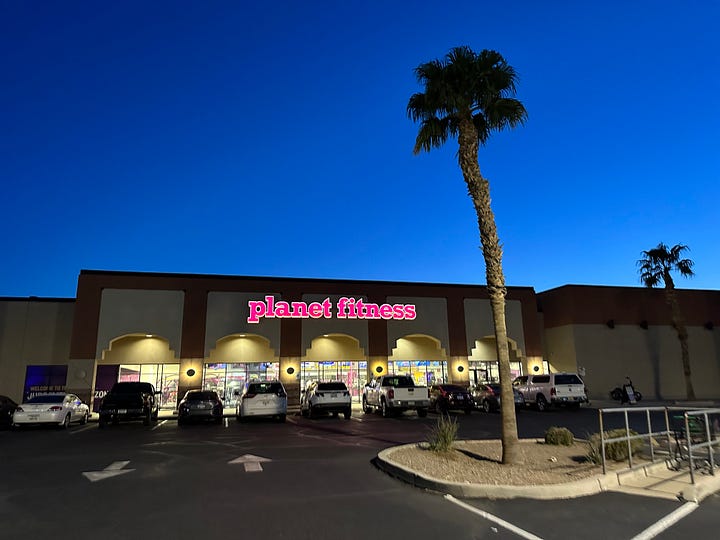
Being in Baja put much of life on hold. Cell service was spotty, and campground Wi-Fi rarely worked. I finally broke down and bought a Starlink* Mini at Home Depot in La Paz on my way north, convinced by a fellow traveler that internet access would make some aspects of van life less stressful (plus, the satellite dish and the service plan cost half as much in Mexico as they do in the US). Yesterday, Glen affixed the Starlink receiver to the roof of my van and wired it into a 12-volt outlet. I now feel like I’ve officially joined the Nomad Club.
(*I have massive misgivings about supporting a company owned by the world’s richest oligarch at this moment in American politics, but my 23-year-old rocket-scientist nephew just landed a job at Starlink, so I’m going to imagine my $80/month paying a small part of his salary… unfortunately they have a monopoly over satellite internet.)
So since I returned Stateside, I’ve been enjoying unlimited gym showers, unbridled internet access, and grocery stores that carry all the foods I like to eat (as a vegan, food shopping was a huge stressor in Mexico). I’ve also been staying put, which limits the frequency of calamities with the van. (In the week between dropping Seth at the airport in Cabo and arriving in Arizona 1,200 miles later, I had a drawer full of books collapse on my head while driving, spent four days at a tire shop making six attempts to get my steering in alignment, and had a grinding sound in my driver’s side window fixed by one of those $150/hour mobile mechanics as soon as I crossed the border.)
Right up until the end, Baja nearly broke me. Every day presented some new challenge (I now know how to talk about my van’s suspension in Spanish!). Life pushed the limits of my health and sanity. I struggled with language barriers, despite my daily dose of Duolingo. I languished in loneliness. My marriage nearly crumbled on a beach in Cabo, then brimmed with possibility overlooking the ocean in La Paz.
But for the most part, I held it together. I accepted what I could not change, and used my many hours at mechanic shops to plan, catch up, write postcards, and make phone calls (pro tip: mechanics have the best internet in Baja!). In the moments I couldn’t hold it together, I let myself fall apart, parking the van and curling up with my dogs and crying myself to sleep.
I benefited from an incredible amount of help and support from people I met along the way—Mexicans who didn’t speak a word of English; American and Canadian expats; travelers and tourists from all over the world. My book-drawer got fixed the next day by Pedro, whose son Juan runs the Four Points Campground in Ciudad Insurgentes (Juan had also taken me on my third gray-whale tour when I stayed with him on my way south, and invited me to his friend’s daughter’s Quincinera). Deme, an American retiree living year-round in Mulege, took my trash into town every day when I was boondocking on a local beach that she visited with her dogs (she also invited me to see a live band at the local brewery during one of my mechanic layovers in town). Blanca and Manuel let me use the shower and dump station at their campground when I couldn’t afford to stay there (I picked up some groceries for them on my next trip to town as a thank-you). Her brother-in-law Martin guided me to visit the 7,000-year-old cave paintings at San Borjitas (which is how I accidentally ended up driving six hours on a four-wheel-drive road in my 26-year-old, two-wheel drive van). Part-time nomads Martina and Thomas planned my whole itinerary, showing me on their map some of the best campsites in Baja. Fellow campers with homes in Oregon, California, Yellowstone, and Alaska invited me to come stay with them on my way north this spring. Arturo at the Palmas Altas Retreat cooked me batches of vegan lentil burgers and tamales (he used to own a vegan restaurant in La Paz). Brenda and Darrell let me camp in their yard and use their shower while I waited a week for my radiator to arrive. Jade, Josie, Frank, and Irit were Baja van-life friends on a similar route who got ahead of me because of my mechanical delays, but kept in touch and sent me tips on campsites and local attractions. John and Britton were a sweet couple from California who caravanned north with me when my alignment was dodgy. A young guy running a purified water station in Loreto gifted me a bottle of fresh-squeezed orange juice and told me in Spanish that I was beautiful. The kindness and generosity of these people and many others kept me going when I was near the end of my rope.

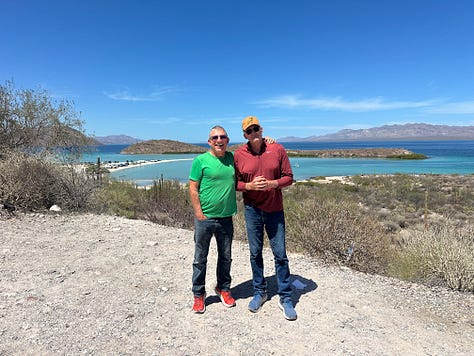
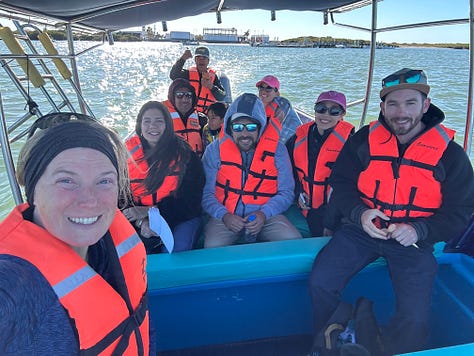
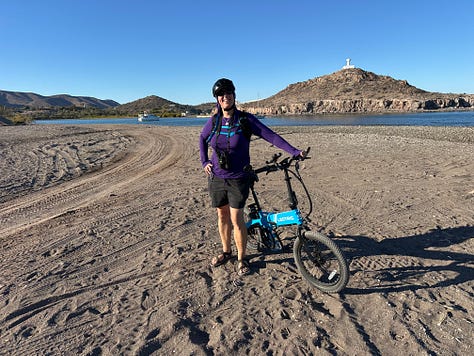
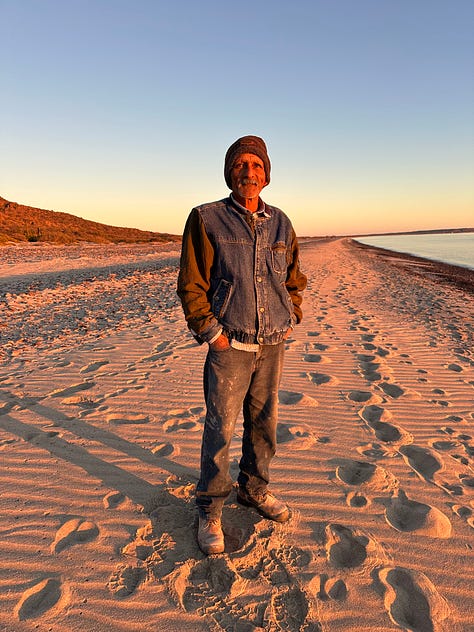



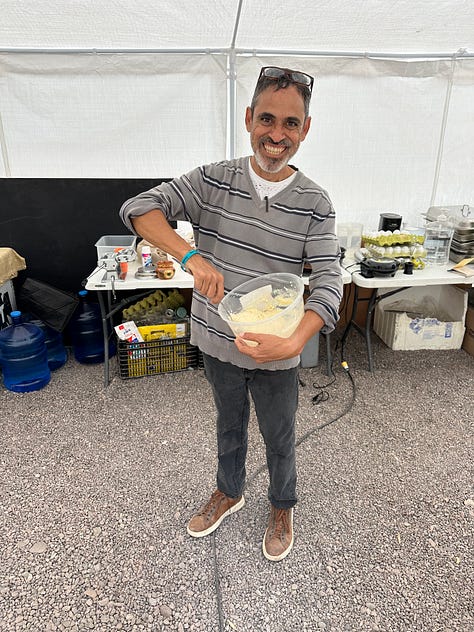
I did my best to pay it forward, too, offering a ride to a former US Park Service employee named Stephanie who was backpacking through Mexico; rescuing a tourist who’d been stung by a stingray in the middle of the bay while I was kayaking; picking up enough plastic debris off one beach to fill an entire trash barrel; grabbing dog poos that didn’t belong to my dogs; giving generous tips to the Mexicans who pumped my gas, bagged my groceries, filled my water tank, and washed my van. I didn’t come close to repaying all the kindness I received, but I did what I could.
In these four-and-a-half months on the road, I realize I’ve fallen into the same trap I found myself in during my trip to Alaska in 2023–driving too much, having too little down-time, doing too many things. Aside from Seth’s visit, the most restorative part of my Baja trip was the two weeks I spent boondocking alone on a white-sand beach, waking up to hummingbirds hovering over the bush in front of my door; watching the sun rise over the ocean; spending my afternoons floating on my inflatable lounge chair on the Sea of Cortez; rushing out to paddle with pods of dolphins when they swam past; collecting giant sand dollars from the shallows; walking down the beach to find exotic-looking shells; jogging along miles of sand with the sun setting behind the cardon cacti on one side and the orange moon reflecting on the ocean on the other side; spending hours watching frigate birds glide, pelicans and terns dive, and surf scoters disappear underwater by the dozen before popping back up again. That spot was so magical for me, I almost didn’t leave (I knew I’d have more problems as soon as I started driving again, and I was right). But if I hadn’t had the courage to get back on the road, I would have missed all the wonders that awaited Seth and me down on the Cape, like watching two huge barracudas glide through green water as I stood at the top of a cliff with Baxter and Laney, watching the sunrise.


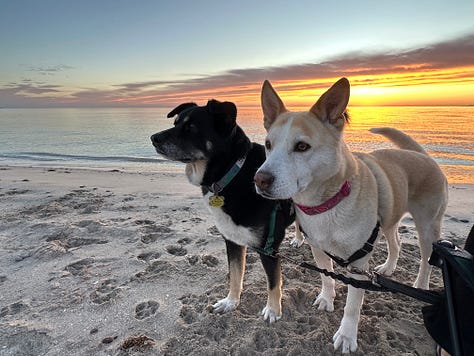
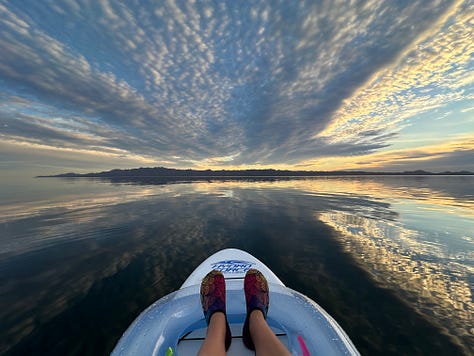
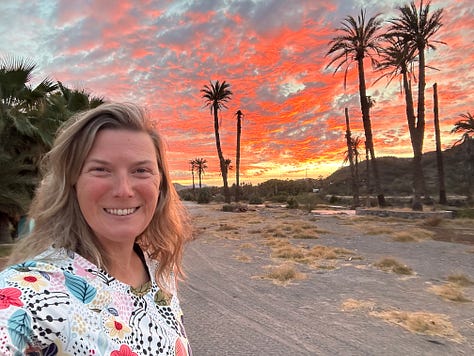
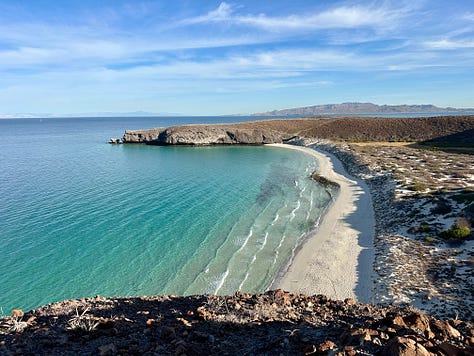

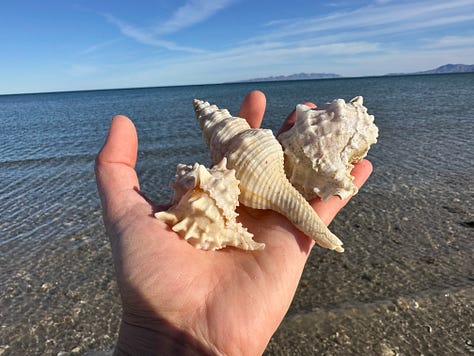
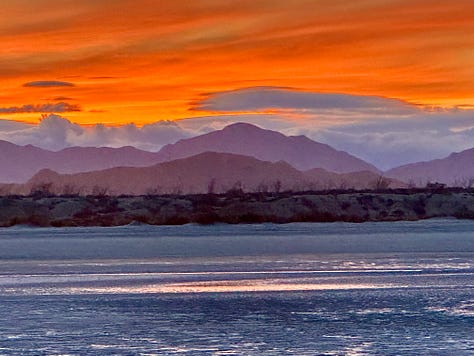
Baja was as full of magic and hospitality as it was riddled with trials and tribulations. As much as I struggled and stressed, everything worked out somehow, and I was fortunate to never find myself in physical danger. Staying safe as a solo female traveling in a foreign country is a huge win. I endured more than my fair share of Murphy’s Law, but I made sure to wring every moment of beauty, awe, and inspiration from the Mexican landscape and people as I could muster. I hope I may bring more of those stories to the page someday, but even if I don’t, they live in my heart, right next to the tremendous pride I feel for traveling alone 2,000 miles down the pothole-ridden peninsula and back.
I’m already planning to return next winter, if life allows me to. And next time, I’ll have scores of friends waiting for me along the way… along with a few mechanics!
NOTE: I wrote this essay on Friday, April 18, 2025 in Prescott, Arizona, but I haven’t had time to proof and post it until now, nearly two weeks later in the middle of California’s Mojave desert (thank you Starlink!). More to come….


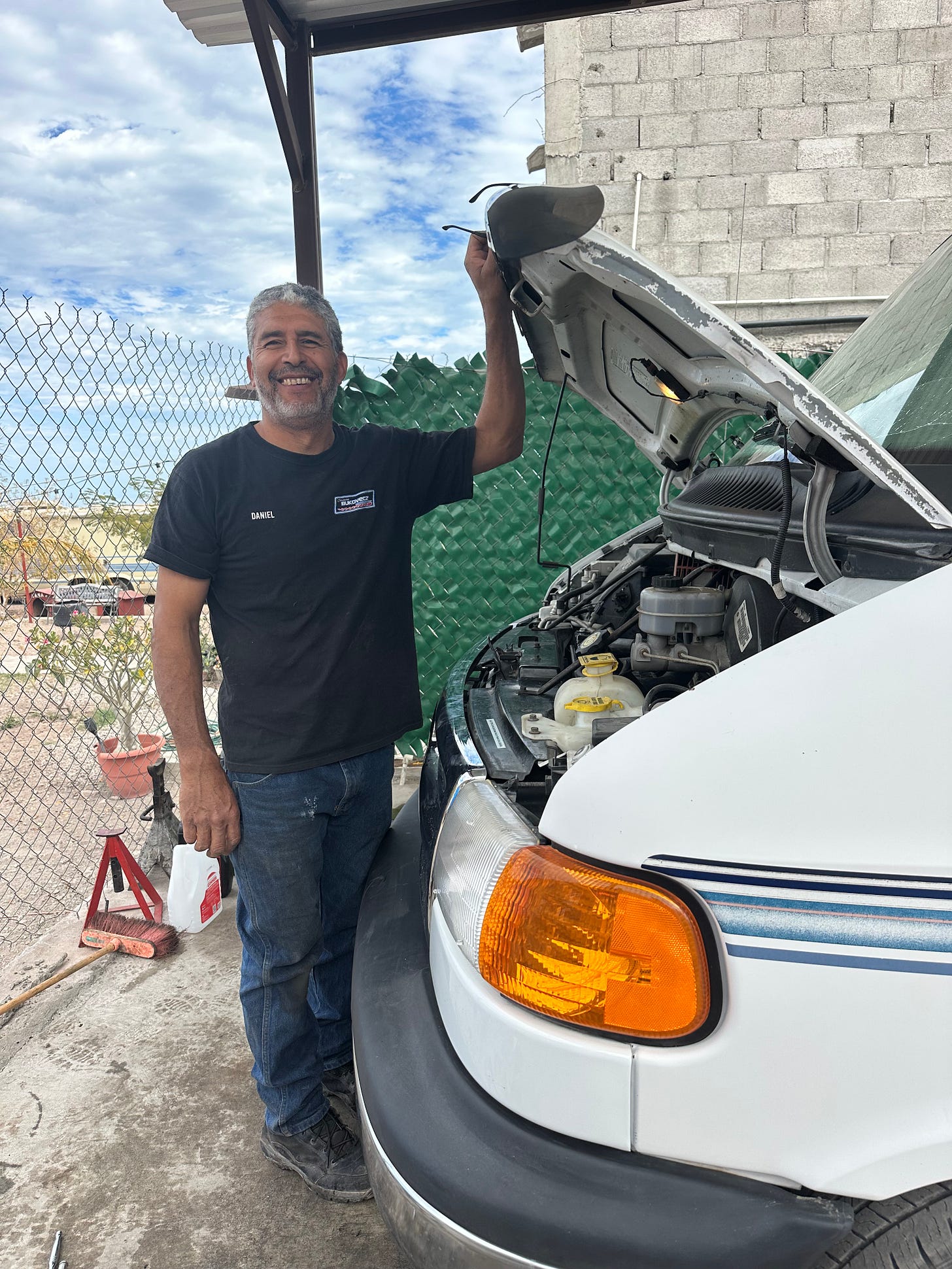
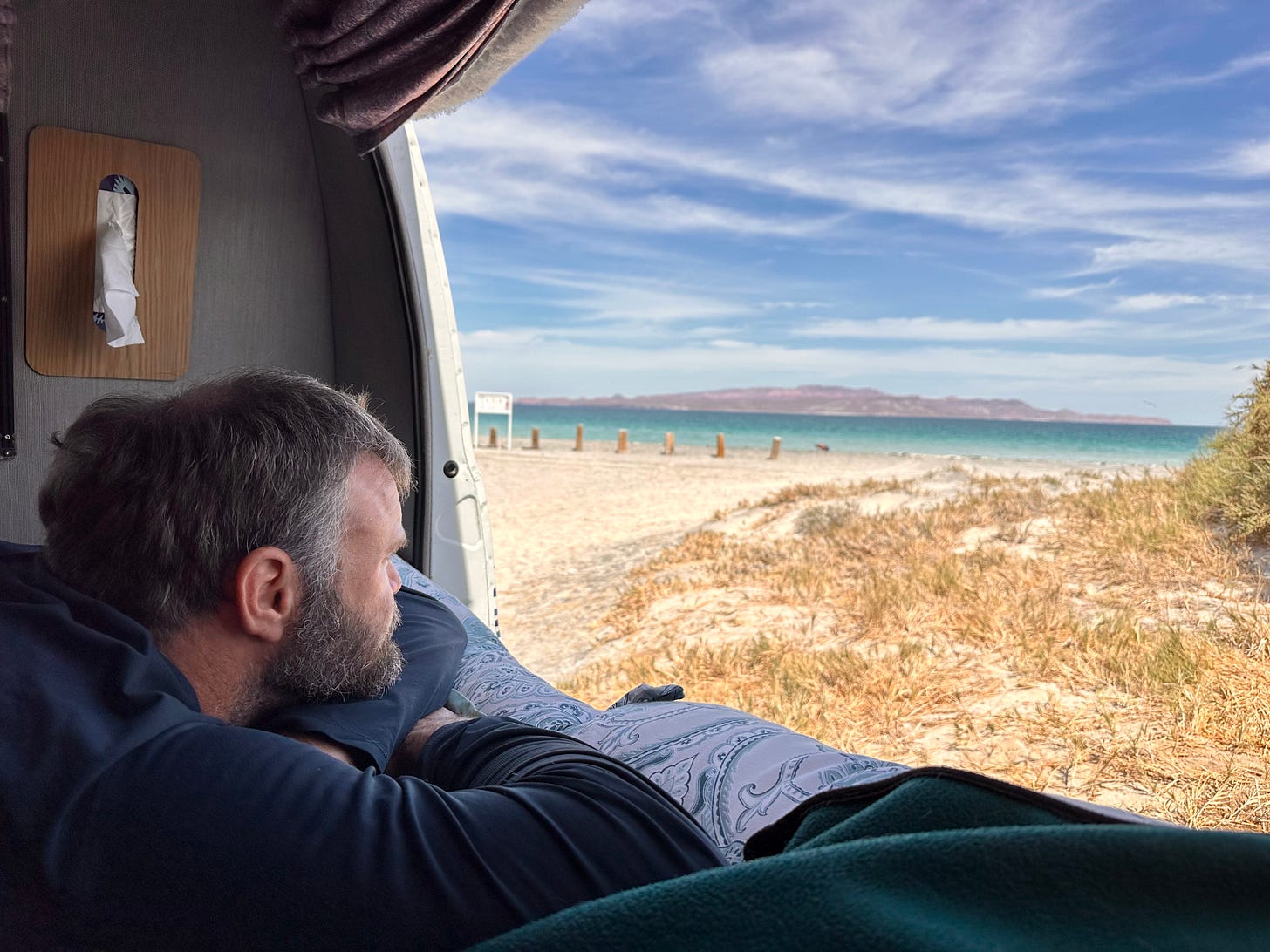


I admire your courage traveling alone. Love the photos of your dogs and the whale diving video. Keep on going!!☀️
Hi Liz:
I work on the road, including AZ and CA, and appreciate your openness about the trials and tribulations. I'm empathetic with trauma, and relate to "museum" metaphor, too.
Cheers to you and stop by Wildlands and say hello!